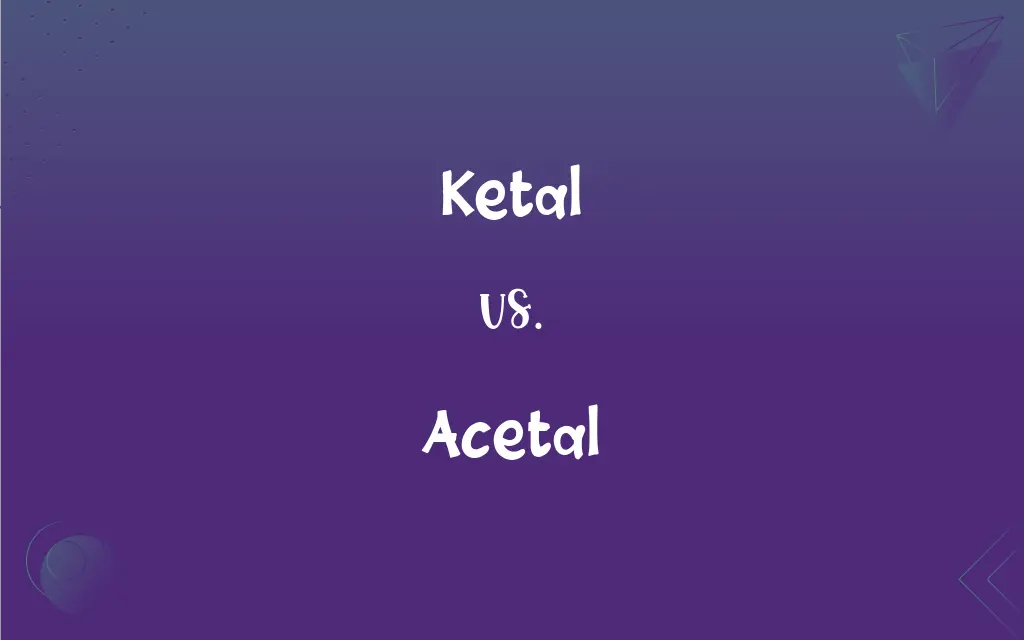Ketal vs. Acetal: What's the Difference?
Edited by Harlon Moss || By Janet White || Published on March 3, 2024
Ketals are compounds formed from ketones and alcohols, while acetals are derived from aldehydes and alcohols.

Key Differences
A ketal is a compound formed when a ketone reacts with two alcohol molecules. An acetal is similarly formed, but it originates from the reaction of an aldehyde with two alcohol molecules.
In ketals, the central carbon atom is connected to two alkyl or aryl groups and two ether groups. In acetals, the central carbon is linked to one alkyl or aryl group and two ether groups.
Ketals are used in organic synthesis as protecting groups for ketones. Acetals serve a similar purpose, but for protecting aldehydes during chemical reactions.
The formation of a ketal involves replacing the oxygen double bond of a ketone with two single-bonded oxygen atoms. Acetal formation involves a similar process but starts with an aldehyde.
Ketals and acetals are stable under neutral conditions but can be hydrolyzed back to their original ketone or aldehyde forms under acidic conditions.
ADVERTISEMENT
Comparison Chart
Origin Compound
Derived from ketones
Derived from aldehydes
Bond Structure
Central carbon bonded to two alkyl/aryl and two ether groups
Central carbon bonded to one alkyl/aryl and two ether groups
Protecting Group For
Protecting ketones in organic synthesis
Protecting aldehydes in chemical reactions
Formation Process
Replaces ketone oxygen double bond with two ether groups
Replaces aldehyde oxygen double bond with two ether groups
Stability and Hydrolysis
Stable under neutral, hydrolyzed under acidic conditions
Stable under neutral, hydrolyzed under acidic conditions
ADVERTISEMENT
Ketal and Acetal Definitions
Ketal
A compound formed from a ketone and two alcohols.
Dimethyl ketal is synthesized from acetone and methanol.
Acetal
A compound formed from an aldehyde and two alcohols.
Ethylene glycol reacts with formaldehyde to form an acetal.
Ketal
Used as a protecting group for ketones in organic synthesis.
The ketone was protected as a ketal to prevent unwanted reactions.
Acetal
Used as a protecting group for aldehydes in organic chemistry.
The aldehyde was converted into an acetal for protection during the reaction.
Ketal
Features a central carbon bonded to two ether groups.
In the ketal structure, the carbon is bonded to two oxygens from alcohols.
Acetal
Contains a central carbon connected to one alkyl group and two ether groups.
In acetal formation, the central carbon bonds with two ether groups.
Ketal
A functional group in organic chemistry.
Ketals are an important functional group in synthesizing complex molecules.
Acetal
Resistant to hydrolysis under neutral conditions, sensitive to acid.
The acetal decomposes to the original aldehyde in acidic conditions.
Ketal
Stable under neutral conditions, but can be hydrolyzed in acid.
The ketal was hydrolyzed back to a ketone in acidic environment.
Acetal
A key functional group in organic compound synthesis.
Acetals play a crucial role in the strategic synthesis of complex organic molecules.
Ketal
(organic chemistry) Any acetal derived from a ketone
Acetal
A colorless, flammable, volatile liquid, C6H14O2, used in perfumes and as a solvent.
Acetal
Any of the class of compounds formed by combination of an aldehyde with two equivalent weights of alcohol.
Acetal
(organic chemistry) Any diether of a geminal diol, R2C(OR')2 (where R' is not H).
Acetal
A limpid, colorless, inflammable liquid from the slow oxidation of alcohol under the influence of platinum black.
Acetal
Any organic compound formed by adding alcohol molecules to aldehyde molecules
FAQs
Are ketals stable in acidic conditions?
No, they are hydrolyzed back to ketones in acidic conditions.
What is an acetal?
An acetal is derived from the reaction of an aldehyde with two alcohol molecules.
How are ketals used in organic synthesis?
They're used as protecting groups for ketones.
Can a ketal form from any ketone?
Yes, most ketones can form ketals when reacted with suitable alcohols.
What is a ketal in chemistry?
It's a compound formed from the reaction of a ketone with two alcohol molecules.
Do acetals form under specific pH conditions?
They usually form under neutral conditions with excess alcohol.
Do acetals have natural occurrences?
Acetals can be found naturally in some biochemical processes.
How do acetals react in acidic environments?
Acetals are hydrolyzed to their original aldehydes in acidic environments.
What's the main use of acetals in chemistry?
Acetals are used as protecting groups for aldehydes.
Are all aldehydes capable of forming acetals?
Generally, yes, aldehydes can form acetals with appropriate alcohols.
How are ketals identified in a chemical structure?
They are identified by two ether groups attached to a central carbon.
What conditions favor the formation of a ketal?
Ketals form under neutral or slightly acidic conditions with excess alcohol.
Can ketals be used in industrial applications?
Yes, they're used in various industrial chemical processes.
What are the industrial uses of acetals?
Acetals are used in perfumery, plastics, and other chemical industries.
What's the difference in the carbon structure between a ketal and an acetal?
Ketals have a central carbon bonded to two alkyl/aryl groups, while acetals have one.
Is the hydrolysis of acetals reversible?
Yes, the hydrolysis of acetals is generally reversible under controlled conditions.
What identifies an acetal in a molecule?
The presence of two ether groups and one alkyl group attached to a central carbon.
Are ketals found naturally?
Ketals can occur naturally but are more commonly synthesized in labs.
Are acetals important in pharmaceutical chemistry?
Yes, they're used in drug development and synthesis.
Can ketals be used in drug synthesis?
Yes, ketals are often used in the synthesis of complex pharmaceuticals.
About Author
Written by
Janet WhiteJanet White has been an esteemed writer and blogger for Difference Wiki. Holding a Master's degree in Science and Medical Journalism from the prestigious Boston University, she has consistently demonstrated her expertise and passion for her field. When she's not immersed in her work, Janet relishes her time exercising, delving into a good book, and cherishing moments with friends and family.
Edited by
Harlon MossHarlon is a seasoned quality moderator and accomplished content writer for Difference Wiki. An alumnus of the prestigious University of California, he earned his degree in Computer Science. Leveraging his academic background, Harlon brings a meticulous and informed perspective to his work, ensuring content accuracy and excellence.







































































